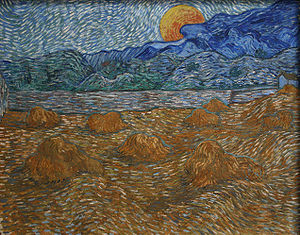Wheat Fields (Van Gogh series)
 |
|
| Artist | Vincent van Gogh |
|---|---|
| Year | early June, 1889 |
| Medium | Oil on canvas |
| Dimensions | 72.0 cm × 92.0 cm (28.3 in × 36.2 in) |
| Location | Kröller-Müller Museum, Otterlo, Netherlands |
The Wheat Fields is a series of dozens of paintings by Vincent van Gogh, borne out of his religious studies and sermons, connection to nature, appreciation of manual laborers and desire to provide a means of offering comfort to others. The wheat field works demonstrate his progression as an artist from the drab Wheat Sheaves made in 1885 in the Netherlands to the colorful, dramatic paintings from Arles, Saint-Rémy and Auvers-sur-Oise of rural France.
Failing to find a vocation in ministry, Van Gogh turned to art as a means to express and communicate his deepest sense of the meaning of life. Cliff Edwards, author of "Van Gogh and God: A Creative Spiritual Quest" wrote: "Vincent's life was a quest for unification, a search for how to integrate the ideas of religion, art, literature, and nature that motivated him."
Van Gogh came to view painting as a calling, "I feel a certain indebtedness [to the world] and... out of gratitude, want to leave some souvenir in the shape of drawings or pictures -- not made to please a certain taste in art, but to express a sincere feeling." When Van Gogh left Paris for Arles, he sought an antidote to the ills of city life and work among laborers in the field "giving his art and life the value he recognized in rural toil."
In the series of paintings about wheat fields, Van Gogh expresses through symbolism and use of color his deeply felt spiritual beliefs, appreciation of manual laborers and connection to nature.
As a young man Van Gogh pursued what he saw as a religious calling, wanting to minister to working people. In 1876 he was assigned a post in Isleworth, England to teach Bible classes and occasionally preach in the Methodist church.
When he returned to the Netherlands he studied for the ministry and also for lay ministry or missionary work without finishing either field of study. With support from his father, Van Gogh went to Borinage in southern Belgium where he nursed and ministered to coal miners. There he obtained a six-month trial position for a small salary where he preached in an old dance hall and established and taught Bible school. His self-imposed zeal and asceticism cost him the position.
...
Wikipedia
